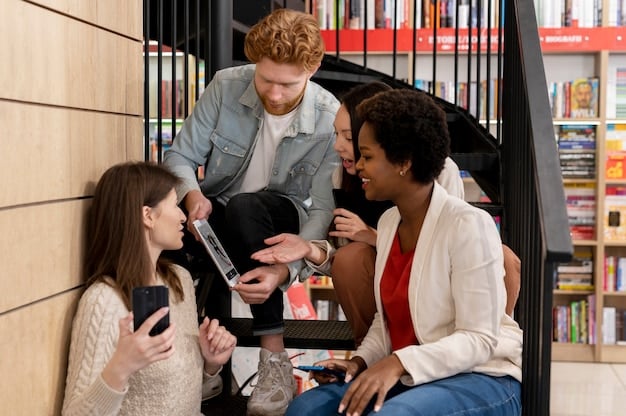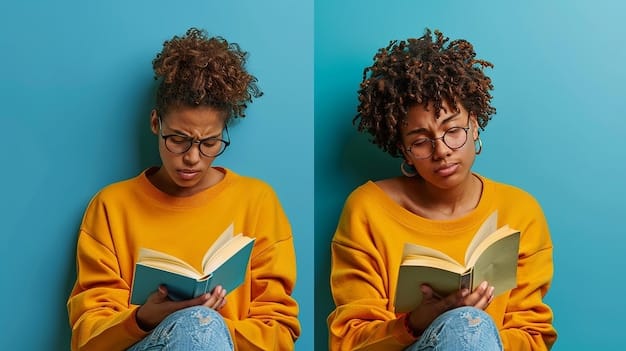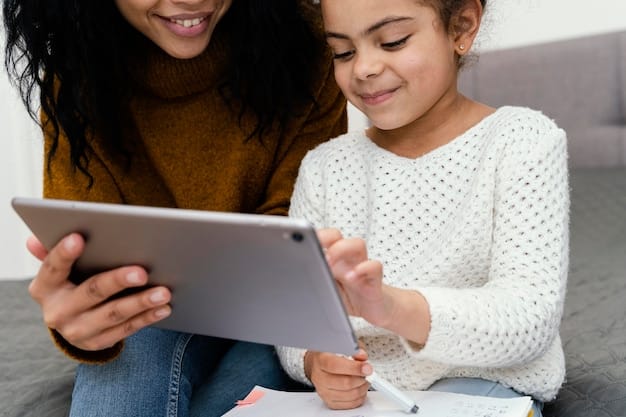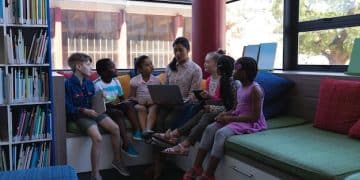Learning Styles in Personalized Education: Shaping the Future US

Learning styles play a crucial role in the evolution of personalized education in the United States, enabling educators to tailor teaching methods to individual student needs and preferences, thereby enhancing engagement and academic outcomes.
In the United States, the concept of personalized education is gaining significant traction, and understanding the role of learning styles in personalized education is becoming increasingly important for educators and students alike. Embracing this approach promises to revolutionize how students learn and achieve their full potential.
Understanding Learning Styles
Learning styles are the approaches individuals prefer and use to learn. Recognizing these styles is essential for creating a personalized educational experience that caters to the unique needs of each student.
What are Learning Styles?
Learning styles refer to the different ways individuals process and retain information. Understanding these styles can help educators tailor their teaching methods to better suit the needs of their students.
Common Learning Style Models
Several models categorize learning styles, including:
* **Visual Learners:** These individuals learn best through seeing. They benefit from diagrams, charts, and videos.
* **Auditory Learners:** Auditory learners prefer listening. They thrive in lectures, discussions, and audio recordings.
* **Kinesthetic Learners:** Kinesthetic learners learn through doing. Hands-on activities, experiments, and movement-based learning are most effective for them.
Each of these learning styles has its own unique characteristics and preferred methods of learning. Educators who understand these differences can create a more inclusive and effective learning environment for all students.

The Importance of Personalized Education
Personalized education focuses on adapting teaching methods to suit individual student needs. This approach recognizes that every student is unique and learns differently.
Personalized education contrasts with the traditional one-size-fits-all approach, which often fails to engage students with diverse learning styles.
By tailoring instruction to meet individual needs, students are more likely to stay engaged, improve their academic performance, and develop a lifelong love of learning.
Benefits of Personalized Education
Personalized education offers several benefits:
* **Increased Engagement:** When students are taught in a way that resonates with their learning style, they are more likely to be engaged and motivated.
* **Improved Academic Performance:** Personalized instruction can lead to better understanding and retention of information.
* **Enhanced Self-Esteem:** When students experience success in learning, their self-esteem improves, fostering a positive attitude toward education.
Integrating Learning Styles into Personalized Education
Integrating learning styles into personalized education involves identifying students’ preferred learning methods and adapting instructional strategies accordingly. This can be achieved through various assessment tools and teaching techniques.
Assessment Tools for Identifying Learning Styles
Several assessment tools can help identify students’ learning styles:
* **Learning Style Questionnaires:** These questionnaires ask students about their preferred learning methods and environments.
* **Observation:** Teachers can observe students in various learning situations to identify patterns in how they learn best.
* **Self-Reflection:** Encouraging students to reflect on their learning experiences can provide valuable insights into their learning styles.
By using these assessment tools, educators can gain a better understanding of each student’s unique learning needs and tailor instruction accordingly.
Adapting Instructional Strategies
Once learning styles are identified, educators can adapt their teaching strategies to meet the needs of their students. For example:
* For visual learners, use more diagrams and charts.
* For auditory learners, incorporate more discussions and lectures.
* For kinesthetic learners, implement more hands-on activities and experiments.
Challenges in Implementing Personalized Education
Implementing personalized education is not without its challenges. These challenges include resource constraints, teacher training, and the need for flexible curriculum design.
One of the primary challenges is the lack of resources. Personalized education requires more individualized attention, which may require additional staff, materials, and technology.
Another challenge is the need for teacher training. Educators need to be trained in how to identify learning styles and adapt their instruction accordingly.
Overcoming the Challenges
To overcome these challenges, schools can consider the following strategies:
* **Allocate Resources Strategically:** Focus on allocating resources to the areas that will have the greatest impact on student learning.
* **Provide Ongoing Teacher Training:** Offer ongoing professional development opportunities for teachers to learn about personalized education and learnign styles.
* **Develop Flexible Curriculum:** Create a curriculum that can be customized to meet the needs of individual students.

The Role of Technology in Personalized Learning
Technology plays a crucial role in facilitating personalized education. Digital tools can provide students with customized learning experiences, track their progress, and offer support as needed.
Technology can provide students with access to a wide range of learning resources, including online courses, interactive simulations, and educational games.
Adaptive learning platforms can also adjust the difficulty of the material based on a student’s performance, ensuring that they are always challenged but not overwhelmed.
Examples of Technology in Personalized Learning
Numerous technology tools support personalized learning:
* **Adaptive Learning Platforms:** These platforms adjust the difficulty of material based on student performance.
* **Educational Apps:** Numerous apps cater to different learning styles and subject areas.
* **Online Courses:** Online courses offer flexibility and customization for students.
By leveraging these technology tools, educators can create a more engaging and effective learning environment for their students.
The Future of Learning Styles in US Education
The future of learning styles in US education looks promising. As educators become more aware of the importance of personalized education, learning styles will likely play an increasingly significant role in instructional design and implementation.
Emerging trends include the use of artificial intelligence (AI) to personalize learning experiences and the development of more sophisticated assessment tools to identify learning styles.
As technology continues to evolve, we can expect to see even more innovative approaches to personalized education that cater to the unique needs of each student.
Predictions for the Future
Looking ahead, here are a few predictions for the future of learning styles in US education:
* **Increased Use of AI:** AI will be used to personalize learning experiences and provide students with individualized support.
* **More Sophisticated Assessment Tools:** New assessment tools will be developed to identify learning styles with greater accuracy.
* **Greater Emphasis on Personalized Learning:** Personalized learning will become the norm in US education, with learning styles playing a central role.
| Key Concept | Brief Description |
|---|---|
| 💡 Learning Styles | Individual approaches to learning, like visual, auditory, and kinesthetic. |
| 🎯 Personalized Education | Tailoring education to meet individual student needs. |
| 🤖 Technology | Tools that help personalize learning, like adaptive platforms and educational apps. |
| 📈 Future Trends | AI and sophisticated tools will further enhance personalized learning. |
Frequently Asked Questions
▼
The primary learning styles include visual, auditory, and kinesthetic. Visual learners learn best through seeing, auditory learners through listening, and kinesthetic learners through doing.
▼
Teachers can identify a student’s learning style through questionnaires, observation, and self-reflection activities. These methods help reveal how students prefer to process information.
▼
Personalized education increases student engagement, improves academic performance, and enhances self-esteem by tailoring instruction to meet individual learning needs and preferences.
▼
Technology supports personalized learning through adaptive platforms, educational apps, and online courses, providing customized learning experiences and tracking student progress effectively.
▼
The future involves increased use of AI, sophisticated assessment tools, and a greater emphasis on personalized learning approaches to cater to each student’s unique learning style.
Conclusion
In conclusion, understanding and integrating learning styles into personalized education is essential for shaping the future of learning in the US. By tailoring instruction to meet the unique needs of each student, educators can create a more engaging, effective, and equitable learning environment.





